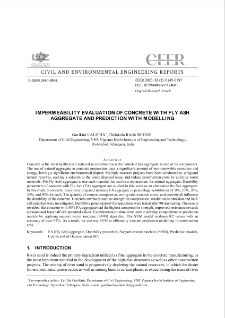Zielonogórska Biblioteka Cyfrowa udostępnia 65 391 obiektów cyfrowych
Obiekt
Tytuł: Impermeability evaluation of concrete with fly ash aggregate and prediction with modelling
Współtwórca:
Tytuł publikacji grupowej:
Abstract:
Concrete is the most synthesized material in construction sector which it has aggregate as one of its components. The use of natural aggregate in concrete preparation uses a significant amount of non-renewable resources and energy, having a significant environmental impact. Multiple research projects have been conducted to safeguard natural reserves, seeking a solution to the waste disposal issue, and reduce construction costs by utilizing waste materials. FA(Fly Ash) aggregate is one such material that can be a replacement for natural aggregate. ; Durability parameters of concrete with Fly Ash (FA) aggregate are studied in this work as an alternative for fine aggregate. In this study, 5 concrete mixes were prepared utilizing FA aggregate in percentage substitution of 0%, 10%, 20%, 30%, and 40% for each. The quantity of cement, compaction, curing rate, concrete cover, and porosity all influence the durability of the concrete. Concrete attributes such as strength in compression, retaliation to abrasion and half-cell potential were investigated. ; Durability parameters of the specimens were tested after 90-day curing. The results revealed that concrete with 30% FA aggregate had the highest compressive strength, improved resistance towards abrasion and least half cell potential values. Experimentation data were used to develop comprehensive prediction models by applying support vector machine (SVM) algorithm. The SVM model analyses R2 values with an accuracy of over 97%. As a result, we can use SVM to efficiently execute prediction modelling in construction area.
Opis:
tytuł dodatkowy: Prace z Inżynierii Lądowej i Środowiska
Wydawca:
Zielona Góra: Oficyna Wydawnicza Uniwersytetu Zielonogórskiego
Format:
Identyfikator zasobu:
DOI:
Strony:
Źródło:
Civil and Environmental Engineering Reports (CEER), no 33, vol. 2
Jezyk:
Licencja CC BY-NC-ND 3.0:
Prawa do dysponowania publikacją:
Biblioteka Uniwersytetu Zielonogórskiego
Kolekcje, do których przypisany jest obiekt:
- Zielonogórska Biblioteka Cyfrowa > Repozytorium > Jednostki organizacyjne > Wydział Budownictwa, Architektury i Inżynierii Środowiska
- Zielonogórska Biblioteka Cyfrowa > Repozytorium > Typy utworów > Artykuły
- Zielonogórska Biblioteka Cyfrowa > Repozytorium > Czasopisma naukowe i serie wydawnicze UZ > Civil and Environmental Engineering Reports (CEER) > Civil and Environmental Engineering Reports (CEER) (2023)
Data ostatniej modyfikacji:
2 lut 2024
Data dodania obiektu:
2 lut 2024
Liczba wyświetleń treści obiektu:
179
Wszystkie dostępne wersje tego obiektu:
https://www.zbc.uz.zgora.pl/publication/86975
Wyświetl opis w formacie RDF:
Wyświetl opis w formacie OAI-PMH:
| Nazwa wydania | Data |
|---|---|
| Impermeability evaluation of concrete with fly ash aggregate and prediction with modelling | 2 lut 2024 |
Obiekty Podobne
Abdelouahed, Assia Hebhoub, Houria Kherraf, Leila Belachia, Mouloud Kuczyński, Tadeusz - red.
Haq, Anam Wilk, Szymon Abelló, Alberto Gamper, Johann - ed. Wrembel, Robert - ed.

